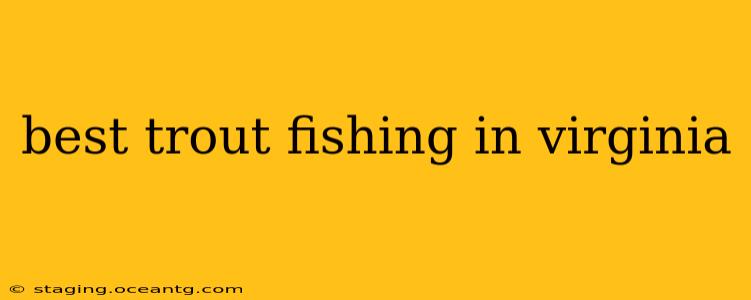Virginia boasts a diverse landscape, from the Blue Ridge Mountains to the Shenandoah Valley, making it a prime destination for trout fishing enthusiasts. Whether you're an experienced angler or a beginner casting your line for the first time, Virginia's many rivers and streams offer a thrilling fishing experience. This guide will explore some of the best trout fishing spots in the state, covering various aspects to help you plan your next fishing adventure.
Where is the Best Trout Fishing in Virginia?
This isn't a simple question with a single answer! The "best" spot depends heavily on your preferred fishing style, the time of year, and your experience level. However, some consistently excellent locations include:
-
The Shenandoah National Park: This park's numerous streams, including the Hazel River and the Rapidan River, offer excellent opportunities for catching wild brook, brown, and rainbow trout. The park's stunning scenery adds to the overall experience.
-
The George Washington and Jefferson National Forests: These expansive forests provide access to a vast network of rivers and streams teeming with trout. The Maury River and the Cowpasture River are particularly popular among anglers.
-
The James River: While known for its larger game fish, sections of the James River, particularly the upper reaches, offer excellent trout fishing opportunities, especially for brown trout.
-
The South Fork of the Shenandoah River: This river system is well-known for its prolific trout populations, offering a mix of wild and stocked fish.
What are the Best Times of Year to Go Trout Fishing in Virginia?
The best time to fish for trout in Virginia generally aligns with the cooler months:
-
Spring (March-May): Spring offers excellent fishing as trout become more active after the winter months. This is a great time to target spawning fish in some areas.
-
Fall (September-November): Fall brings crisp air and vibrant foliage, along with active trout feeding before winter sets in.
-
Winter (December-February): While some streams may be icy, many remain fishable, offering a unique and less crowded angling experience for those willing to brave the cold.
What are the Best Types of Trout Found in Virginia?
Virginia is home to several trout species, each offering a unique fishing challenge:
-
Rainbow Trout: A popular and widely stocked species, rainbow trout are known for their vibrant colors and aggressive feeding habits.
-
Brown Trout: Native to Europe, brown trout have adapted well to Virginia's waters, offering a more challenging fight compared to rainbow trout.
-
Brook Trout: The state fish of Virginia, brook trout are a native species found primarily in higher elevation streams. Their stunning coloration makes them a prized catch for many anglers.
What are the Regulations for Trout Fishing in Virginia?
Virginia Department of Wildlife Resources (DWR) regulates trout fishing, including licensing requirements, creel limits, and size restrictions. It's crucial to familiarize yourself with these regulations before heading out. You can find detailed information on the DWR website.
What is the Best Bait for Trout Fishing in Virginia?
The best bait will vary depending on the time of year, water conditions, and the type of trout you're targeting. However, some consistently effective options include:
-
Worms: A classic and reliable choice, worms are effective for both wild and stocked trout.
-
Insects: Imitating natural insect life with artificial flies or lures is a popular method, particularly among fly fishermen.
-
Spinnerbaits and Spoons: These lures can be effective for covering water and attracting trout.
What are Some Tips for Successful Trout Fishing in Virginia?
- Know the Regulations: Always be aware of and comply with the current fishing regulations.
- Choose the Right Gear: Select appropriate rods, reels, lines, and lures based on your target species and the fishing conditions.
- Be Patient and Observant: Trout are often finicky, so patience and careful observation are key to success.
- Respect the Environment: Practice Leave No Trace principles to preserve Virginia's beautiful waterways.
By understanding these key aspects of trout fishing in Virginia, you can significantly increase your chances of a successful and memorable fishing trip. Remember to check the Virginia Department of Wildlife Resources website for the most up-to-date information on regulations, stocking reports, and fishing access. Happy fishing!
